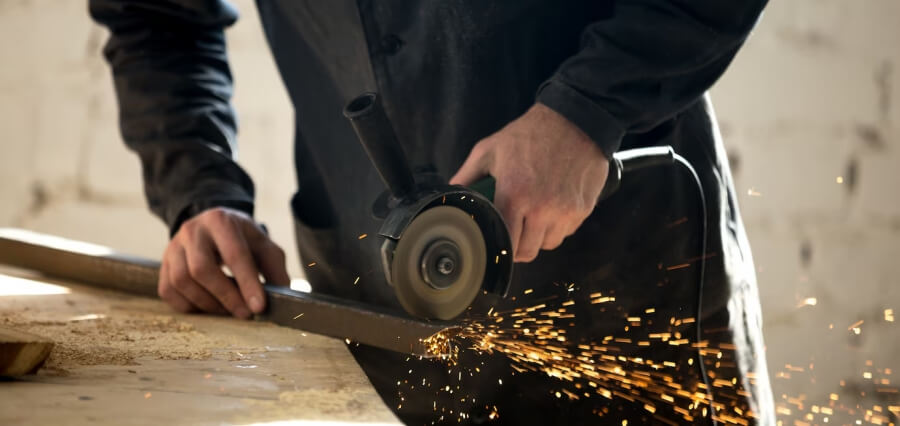Angle grinders are versatile power tools that are essential for various tasks such as grinding, cutting, polishing, and sanding. Choosing the right angle grinder can significantly impact the efficiency and quality of your work. Here’s a comprehensive guide on the essential features to look for when you buy angle grinders.
- Power Source
Angle grinders are powered by different sources, and the type of power source you choose will depend on your specific needs and work environment.
Options:
Electric: These are the most common and are available in both corded and cordless versions. Corded grinders offer continuous power and are suitable for heavy-duty tasks, while cordless grinders provide more mobility and are ideal for tasks that require movement.
Pneumatic: Powered by air compressors, pneumatic grinders are lightweight and offer high power. They are commonly used in industrial settings.
Gas-powered: These are less common but are used in remote locations where electricity is not available.
- Disc Size
The disc size determines the depth of the cut and the surface area that can be worked on.
Common Sizes:
4.5 inches: Suitable for most DIY projects and general-purpose use.
5 inches: Offers a bit more cutting depth while still being manageable.
7 to 9 inches: Best for heavy-duty tasks and industrial applications.
- Motor Power
The motor power of an angle grinder is measured in watts or horsepower and determines the tool’s ability to perform demanding tasks.
Considerations:
DIY and Light-duty Use: A grinder with a power rating of 500 to 1000 watts is sufficient.
Medium-duty Use: Look for a power rating of 1000 to 1500 watts.
Heavy-duty and Industrial Use: Opt for a grinder with more than 1500 watts.
- Speed
An angle grinder’s speed is expressed in revolutions per minute (RPM). Higher RPMs provide faster cutting and grinding but can be harder to control.
Tips:
Variable Speed Control: A grinder with variable speed control allows you to adjust the speed based on the task, providing greater versatility and precision.
Typical RPM: Look for grinders with an RPM range of 5,000 to 10,000. For specialized tasks, a higher RPM may be necessary.
- Safety Features
Safety should be a top priority when selecting an angle grinder. Here are some essential safety features to look for:
Features:
Adjustable Guard: Protects you from debris and sparks. Ensure it is easy to adjust without tools.
Spindle Lock: Allows for quick and easy disc changes.
Anti-kickback: Prevents the grinder from jerking back towards you if the disc binds in the material.
Restart Protection: Prevents the tool from restarting automatically after a power outage.
Soft Start: Reduces the initial surge of power, making it easier to control the tool upon startup.
- Ergonomics and Design
A comfortable and well-designed angle grinder can reduce fatigue and increase productivity.
Considerations:
Handle Design: Look for a grinder with a comfortable and ergonomic handle. A side handle that can be adjusted to different positions is also beneficial for better control.
Weight: Lighter grinders are easier to handle and control, especially for extended use. However, ensure it’s balanced with the power needed for your tasks.
Vibration Control: Some grinders come with anti-vibration features to reduce hand fatigue and improve comfort during prolonged use.
- Durability and Build Quality
The durability and build quality of an angle grinder affect its lifespan and performance.
Tips:
Housing Material: Choose a grinder with a robust housing material, such as metal or high-quality plastic, that can withstand rough handling.
Sealed Bearings: Help prevent dust and debris from entering the motor, extending the tool’s life.
Warranty: A good warranty can give you peace of mind and indicate the manufacturer’s confidence in their product.
- Disc and Accessory Compatibility
Ensure that the angle grinder you choose is compatible with a variety of discs and accessories for different applications.
Considerations:
Disc Type: Different tasks require different discs. Common types include grinding discs, cutting discs, flap discs, and wire wheels.
Disc Change System: A tool-less disc change system can save time and make switching between tasks easier.
Accessory Range: Check if the grinder is compatible with a wide range of accessories, such as dust shrouds, guard attachments, and different types of discs.
- Ease of Maintenance
Regular maintenance is crucial for the longevity and optimal performance of your angle grinder.
Tips:
Brush Replacement: Some grinders come with easy-access brush replacement features, which make maintaining the motor simpler.
Dust Ejection System: Helps prevent dust and debris from clogging the motor, reducing the need for frequent cleaning and maintenance.
- Price and Brand Reputation
While price is an important factor, it should not be the sole deciding factor. The brand’s reputation and the tool’s overall value are equally important.
Tips:
Brand Reputation: Choose a well-known brand with positive reviews and a good track record for reliability and customer service.
Value for Money: Compare features and prices across different models to find the best value. Sometimes paying a bit more upfront can save you money in the long run with a more durable and efficient tool.
Select the Right Angle Grinder
Selecting the right angle grinder involves considering various features and how they align with your specific needs. By evaluating power source options, disc sizes, motor power, speed, safety features, ergonomics, durability, accessory compatibility, ease of maintenance, and brand reputation, you can ensure you make an informed decision. Investing time in choosing the right angle grinder will not only enhance your productivity but also ensure your safety and satisfaction in the long run.














